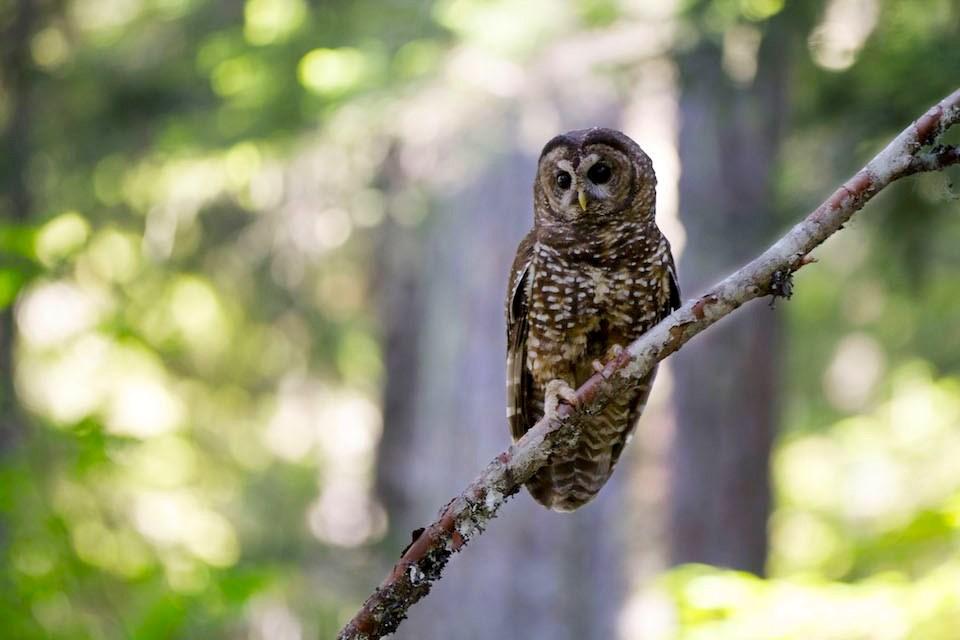
Northern spotted owls, currently considered a threatened species, deserve to be listed as endangered, according to the U.S. Fish and Wildlife Service/NPS, Emily Brouwer
Editor's note: This corrects that a subspecies of Northern Spotted Owl, the California Spotted Owl, occurs in Muir Woods, Golden Gate, and Yosemite, and adds that the Northern Spotted Owl has in the past been seen in North Cascades National Park and Crater Lake National Park.
While Northern spotted owls deserve to be listed as an endangered species, the U.S. Fish and Wildlife Service said there are too many other priority species at this time to address that need.
"A listing proposal is precluded if the Service does not have sufficient resources available to complete the proposal, because there are competing demands for those resources, and the relative priority of those competing demands is higher," the agency said in a statement to be posted in the Federal Register on Tuesday.
"Thus, in any given fiscal year, multiple factors dictate whether it will be possible to undertake work on a proposed listing regulation or whether promulgation of such a proposal is precluded by higher priority listing actions—(1) The amount of resources available for completing the listing function, (2) the estimated cost of completing the proposed listing regulation, and (3) the Service’s workload, along with the Service’s prioritization of the proposed listing regulation, in relation to other actions in its workload."
That news drew criticism Monday from the Western Environmental Law Center, which claims the Fish and Wildlife Service has had nearly a decade to address the owl's status, which has been listed as threatened.
“On the one hand, you have biologists at the U.S. Fish and Wildlife Service acknowledging that Northern spotted owls are extremely close to extinction and more must be done to prevent the extinction of the species,” said Susan Jane Brown, attorney at the Western Environmental Law Center. “On the other, you have the Trump administration catering to the demands of an out-of-touch timber industry. Placing commercial interests ahead of the continued existence of this iconic species is shameful, and thankfully, not permitted by the Endangered Species Act.
“Despite today’s announcement that the Northern spotted owl is ‘unofficially endangered’ and likely to go extinct, the Service has prioritized working against its recovery under the Trump administration,” Brown added. “We will wait and see what further decisions the Service makes regarding the fate of the spotted owl before deciding how we move forward in light of today’s announcement."
Habitat for the owl can be found in Olympic National Park, Mount Rainier National Park, North Cascades National Park and Crater Lake National Park, as well as at Muir Woods National Monument, Point Reyes National Seashore, and Golden Gate National Recreation Area.
In August 2019, the American Ornithological Society said "... new research shows that the Spotted Owl population in Washington's Mount Rainier National Park has declined sharply in the past two decades despite long-term preservation of habitat within the park. The culprit? The Barred Owl, a competing species that has moved into Spotted Owls' range from the east."




 Support Essential Coverage of Essential Places
Support Essential Coverage of Essential Places







Comments
The correction appears to be incorrect. First, the California Spotted Owl is NOT a subspecies of the Northern Spotted Owl. They are each subspecies of the Spotted Owl. There is also a Mexican Spotted Owl, another subspecies. It IS the Northern Spotted Owl, NOT the California Spotted Owl, that occurs at the southern-most extent of its range in Point Reyes National Seashore, Muir Woods Nationa Monument and Golden Gate National Recreation Area.
Daphne Hatch
Retired Chief of Natural Reaources, GGNRA
Thanks for straightening us out, Daphne. Obviously, we need a natural resources editor full-time.